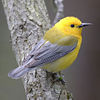Galliformes
| Galliformes | ||||||||||||
|---|---|---|---|---|---|---|---|---|---|---|---|---|
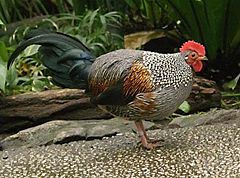 Male Grey Junglefowl, Gallus sonneratii
|
||||||||||||
| Scientific classification | ||||||||||||
|
||||||||||||
| Families | ||||||||||||
|
Megapodiidae |
||||||||||||
| Synonyms | ||||||||||||
|
Craciformes |
Galliformes are an order of birds containing turkeys, grouse, chickens, quails, and pheasants. More than 250 living species are found worldwide. Common names are gamefowl or gamebirds, landfowl, gallinaceous birds or galliforms. "Wildfowl" or just "fowl" are also often used for Galliformes, but usually these terms also refer to waterfowl, and occasionally to other commonly-hunted birds.
Contents |
Description

These birds vary in size from the diminutive Asian Blue Quail (Coturnix chinensis) at 12.5 centimetres (5 in) long and weighing 28 to 40 grams (1 to 1.4 oz) to the largest extant galliform species, the North American Wild Turkey (Meleagris gallopavo), which may weigh as much as 14 kilograms (about 30.5 lb) and may exceed 120 centimetres (47 in).
The galliform bird species with the largest wing-span is most likely the Green Peafowl (Pavo muticus). Most galliform genera are plump-bodied with thick necks and moderately long legs, and have rounded and rather short wings. Grouse, pheasants, francolins, and partridges are typical in their outwardly corpulent silhouettes. While most galliforms are rather weak-flying, flightless forms are unknown among the living members of the order. The Sylviornis, a huge prehistorically extinct mound-builder relative of New Caledonia, was flightless, but as opposed to most other flightless birds like ratites or island rails which become flightless due to arrested development of their flight apparatus and subsequently evolve to larger size, the Sylviornis seems to have become flightless simply due to its bulk, with the wing reduction following a consequence, not the reason for its flightlessness. There are a number of prehistorically extinct mound-builders from Pacific islands, and these seem to have arrived at flightlessness in the more conventional way.
Adult males of many galliform birds have one to several sharp horny spurs on the back of each leg, which they use for fighting. In several lineages, there is pronounced sexual dimorphism, and among each galliform clade, the more apomorphic ("advanced") lineages tend to be more sexually dimorphic.
Ecology
Most of the galliform birds are more or less resident, but some of the smaller temperate species (such as quail) do migrate over considerable distances. Altitudinal migration is evidently quite common amongst montane species and a few species of subtropical and subarctic regions must reach their watering and/or foraging areas through sustained flight. Species known to make extensive flights include the ptarmigans, sage-grouse (Centrocercus), Crested Wood-partridge, Green Peafowl, Crested Argus, Mountain Peacock-pheasant (Polyplectron inopinatum), Koklass (Pucrasia macrolopha), Reeves's Pheasant (Syrmaticus reevesii) and Green Junglefowl (Gallus varius). Other species — for example, most of the New World quails (also known as the toothed quails), the enigmatic Stone Partridge (Ptilopachus petrosus) of Africa, guineafowl and eared-pheasants (Crossoptilon) — are all notable for their daily excursions on foot which may take them many miles in a given day.
Some Galliformes are adapted to grassland habitat, and these genera are remarkable for their long, thin necks, long legs and large, wide wings. Fairly unrelated species like the Crested Fireback (Lophura ignita), Vulturine Guineafowl (Acryllium vulturinum) and Malleefowl (Leipoa ocellata) are outwardly similar in their body types (see also convergent evolution).
Most species that show only limited sexual dimorphism are notable for the great amount of locomotion required to find food throughout the majority of the year. Those species that are highly sedentary but with marked ecological transformations over seasons exhibit marked distinct differences between the sexes in size and/or appearance. Eared-pheasants, guineafowls, toothed quails and the Snow Partridge (Lerwa lerwa) are examples of limited sexual differences and requirements for traveling over wide terrain to forage.
The Bronze-tailed Peacock-pheasant (Polyplectron chalcurum), Snow Partridge, Painted Spurfowl (Galloperdix lunulata) and the Crimson-headed Partridge (Haematortyx sanguiniceps) are notable in their habit of moving around as pairs not only on foot but also in the air.
Food and feeding
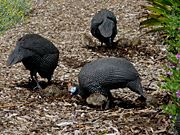
Herbivorous to slightly omnivorous galliforms, comprising the majority of the group, are typically stoutly built and have short thick bills primarily adapted for foraging on the ground for rootlets or the consumption of other plant material such as heather shoots. The young birds will also take insects.
Peafowl, junglefowl and most of the subtropical pheasant genera have very different nutritional requirements from typical Palearctic genera. The Himalayan Monal (Lophophorus impejanus) has been observed digging in the rotting wood of deadfall in a similar manner to woodpeckers to extract invertebrates, even bracing itself with aid of its squared tail. The Cheer Pheasant (Catreus wallichi), Crested Argus (Rheinardia ocellata), the Crested Wood-partridge (Rollulus roulroul) and the Crested Guineafowl (Guttera pucherani) are similar ecologically to the Himalayan Monal in that they too forage in rotting wood for termites, ant and beetle larvae, molluscs, crustaceans and young rodents.
Typical peafowl (Pavo), most of the peacock-pheasants (Polyplectron), the Bulwer's Pheasant (Lophura bulweri), the ruffed pheasants (Chrysolophus) and the hill partridges (Arborophila) have narrow, relatively delicate bills, poorly suited for digging. These Galliform genera prefer instead to capture live invertebrates in leaf litter, in sand and in shallow pools or along stream banks. These genera are also outwardly similar in that they each have exceptionally long, delicate legs and toes and the tendency to frequent seasonally wet habitats to forage, especially during chick-rearing. The Blue Peafowl (Pavo cristatus) is famed in its native India for its appetite for snakes - even poisonous cobras - which it dispatches with its strong feet and sharp bill. The Lady Amherst's Pheasant (Chrysolophus amherstiae), Green Peafowl (Pavo muticus), Bulwer's Pheasant and the Crestless Fireback (Lophura erythrophthalma) are notable for their aptitude to forage for crustaceans such as crayfish and other aquatic small animals in shallow streams and amongst rushes in much the same manner as some members of the rail family (Rallidae).
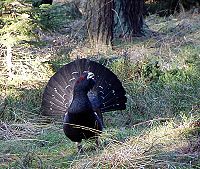
The tragopans (Tragopan), Mikado Pheasant (Syrmaticus mikado) and several species of grouse and ptarmigan are exceptional in their largely vegetarian and arboreal foraging habitats; grouse are especially notable for being able to feed on plants rich in terpenes and quinones - such as sagebrush or conifers -, which are often avoided by other herbivores. But many species of moderate altitudes — for example the long-tailed pheasants of the genus Syrmaticus — also find a great deal of their daily nutritional reqirements in the tree canopies, especially during the snowy and rainy periods when foraging on the ground is dangerous and less than fruitful for a variety of reasons. Although members of the genus Syrmaticus are capable of subsisting almost entirely on vegetarian materials for months at a time, this is not true for many of the subtropical genera. For example, the Great Argus (Argusianus argus) and Crested Argus may do most of their foraging during rainy months in the canopy of the jungle as well. There they are known to forage on slugs, snails, ants and amphibians to the exclusion of plant material. How they forage in the forest canopy during the rainy months is unknown but is a compelling issue for future investigations.
Reproduction
Most galliforms are very prolific, with clutches regularly exceeding 10 eggs in many species. In contrast to most birds which are - at least for a particular breeding season - monogamous, galliforms are often polygynous or polygamous. Such species can be recognized by their pronounced sexual dimorphism.
Galliform young are very precocious and will roam their habitat with their mothers - or both parents in monogamous species - mere hours after hatching. The most extreme case are the Megapodidae, where the adults do not brood but leave incubation to mounds of rotting vegetation, volcanic ash or hot sand. The young have to dig their way out of the nest mounds after hatching, but they emerge from the eggs fully feathered and as soon as they leave the mound, they are able to fly for considerable distances.
Systematics and evolution
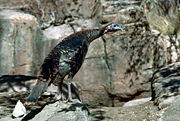
The living Galliformes were long divided into some 7 or more families. More recently, it is generally believed that the quite distincly-appearing grouse and turkeys do not warrant separation as families due to their quite recent origin from partridge- or pheasant-like birds. As it seems, the turkeys became huge after their ancestors colonized temperate and subtropical North America where pheasant-sized competitors were absent. The ancestors of grouse, on the other hand, adapted to harsh climate and thus grouse could colonize subarctic regions. Consequently the Phasianidae are expanded in current treatments to include the former Tetraonidae and Meleagrididae as subfamilies.[1]
The Anseriformes (waterfowl) and the Galliformes together make up the Galloanserae. They are basal among the living neognathous birds, and normally follow the Paleognathae (ratites and tinamous) in modern bird classification systems. This was first proposed in the Sibley-Ahlquist taxonomy and has been the one major change of that proposed scheme that was almost universally adopted. On the other hand, the Galliformes as they were traditionally delimited are called Gallomorphae in the Sibley-Ahlquist taxonomy, which splits the Cracidae and Megapodidae as an order "Craciformes". This is not a natural group however, but rather an erroneous result of the now-obsolete phenetic methodology employed in the Sibley-Ahlquist taxonomy[2]. Phenetic studies do not distinguish between plesiomorphic and apomorphic characters, which leads to basal lineages appearing as monophyletic groups.
Historically, the buttonquails (Turnicidae), mesites (Mesitornithidae) and the Hoatzin (Opisthocomus hoazin) were placed in the Galliformes too. The former are now known to be shorebirds adapted to an inland lifestyle, whereas the mesites are probably related to at least some of the birds traditionally in the "Gruiformes" assemblage. The relationships of the Hoatzin are entirely obscure, and it is usually treated as a monotypic order Opisthocomiformes to signify this.
Evolution
Given that the oldest known waterfowl, Vegavis iaai, dates form the Late Cretaceous, galliform ancestors must also have roamed the Earth contemporaneously with animals such as Tyrannosaurus rex[3].
Indeed, there exist a few fragmentary fossils of putative galliforms from the Cretaceous, of which the most interesting fossil taxon is Austinornis. Formerly referred to as Ichthyornis lentus, Graculavus lentus or Pedioecetes lentus, its partial left tarsometatarsus was found in the Late Cretaceous Austin Chalk near Fort McKinney, Texas. This bird was quite certainly closely related to Galliformes, but whether it was a part of these or belongs elsewhere in the little-known galliform branch of Galloanserae is not clear.[4]
Other Mesozoic fossils are referred to the Galliformes with considerably less certainty: The very enigmatic Gallornis living in today's France some 140-130 million years ago (mya) was as far as anyone can tell an ornithuran. But although the possibility that it was a very early galliform cannot be positively excluded, its ancient age makes this seem not particularly likely. The case of Austinornis shows that it is certainly possible to confuse a possible galliform with more primitive ornithurans like Ichthyornis.
Specimen PVPH 237 from the Late Cretaceous Portezuelo Formation (Turonian-Coniacian, about 90 mya) in the Sierra de Portezuelo (Argentina) may also be a galliform. This is a partial coracoid of a neornithine bird, which in its general shape and particularly the wide and deep attachment for the muscle joining the coracoid and the humerus (upper arm) bone resembles the more basal lineages of galliforms.[5]
The Paleogene had several galliforms of now-extinct families, namely the Gallinuloididae, Paraortygidae and Quercymegapodiidae. In the early Cenozoic, there are some additional birds that may or may not be early Galliformes, though even if they are, it is rather unlikely that these belong to extant families:
- †Argillipes (London Clay Early Eocene of England)
- †Coturnipes (Early Eocene of England, and Virginia, USA?)
- †Paleophasianus (Willwood Early Eocene of Bighorn County, USA)
- †Percolinus (London Clay Early Eocene of England)
- †"Palaeorallus" alienus (middle Oligocene of Tatal-Gol, Mongolia)
- †Anisolornis (Santa Cruz Middle Miocene of Karaihen, Argentina)
From the mid-Eocene onwards - about 45 mya or so -, modern-type galliforms are known, and these completely replace their older relatives in the early Neogene. Since the earliest representatives of living galliform families apparently belong to the Phasianidae - the youngest family of galliforms -, the other families of Galliformes must be at least of Early Eocene origin but might even be as old as the Late Cretaceous. The ichnotaxon Tristraguloolithus cracioides is based on fossil eggshell fragments from the Late Cretaceous Oldman Formation of southern Alberta, Canada which are similar to chachalaca eggs[6], but in the absence of bone material their relationships cannot be determined except that they are apparently not from a non-avian dinosaur.
Modern genera of phasianids start appearing around the Oligo-/Miocene boundary, roughly 25-20 mya. It is not well known whether the living genera of the other, older, galliform families originated around the same time or earlier, though at least in the New World quails, pre-Neogene forms seem to belong to genera that became entirely extinct later on.
A number of Paleogene to mid-Neogene fossils are quite certainly Galliformes, but their exact relationships in the order cannot be determined:

- †Austinornis (Austin Chalk Late Cretaceous of Fort McKinney, USA) - tentatively placed here, formerly Graculavus/Ichthyornis/Pedioecetes lentus
- †Procrax (middle Eocene? - Early Oligocene) - cracid? gallinuloidid?
- †Palaeortyx (middle Eocene -? Early Pliocene) - phasianid or odontophorid
- †Palaeonossax (Brule Late Oligocene of South Dakota, USA) - cracid?
- †Taoperdix (Late Oligocene)
- †Archaealectrornis (Oligocene) - phasianid?
- †Galliformes gen. et sp. indet. (Oligocene) - formerly in Gallinuloides; phasianid?[7]
- †Archaeophasianus (Oligocene? - Late Miocene) - tetraonid or phasianid
- †Palaealectoris (Agate Fossil Beds Early Miocene of Sioux County, USA) - tetraonid?
- †Linquornis (middle Miocene)
- †Palaeoalectoris (Xiacaowan middle Miocene of Sihong, China)
- †Shandongornis (middle Miocene)
- †"Cyrtonyx" tedfordi (Barstow Late Miocene of Barstow, USA)
List of major taxa
For a long time, the pheasants, partridges and relatives were indiscriminately lumped in the Phasianidae, variously including or excluding turkeys, grouse, New World quails and guineafowl, and divided into two subfamilies - the Phasianinae (pheasant-like forms) and the Perdicinae (partridge-like forms). This crude arrangement was long considered to be in serious need of revision, but even with modern DNA sequence analyses and cladistic methods, the phylogeny of the Phasianidae has resisted complete resolution.[8]
A tentative list of the higher-level galliform taxa, listed in evolutionary sequence, is:[8]
- Family †Paraortygidae
- Family †Quercymegapodiidae
- Family †Sylviornithidae - Sylviornis
- Family Megapodidae - mound-builders and scrubfowl, or megapodes
- Family Cracidae - chachalacas, guans and curassows
- Superfamily Phasianoidea
- Family †Gallinuloididae - tentatively placed here
- Family Odontophoridae - New World quail
- Family Numididae - guineafowl
- Family Phasianidae - pheasants, partridges and relatives
- Subfamily Arborophilinae - jungle- and wood-partridges
- Subfamily Coturnicinae - Old World quails, scrub-partridges and spurfowl
- Subfamily Pavoninae - peafowl and ocellated pheasants
- Subfamily Gallininae - francolins and junglefowl
- Subfamily Meleagridinae - turkeys
- Subfamily Perdicinae - grey partridges (probably belong in either Meleagridinae or Phasianinae)
- Subfamily Tetraoninae - grouse
- Subfamily Phasianinae - true pheasants
The relationships of many pheasants and partridges are still very badly resolved and much confounded by adaptive radiation (in the former) and convergent evolution (in the latter)[9]. Thus, the bulk of the Phasianidae can alternatively be treated as a single subfamily Phasianinae. The grouse, turkeys, true pheasants etc would then become tribes of this subfamily, similar of how the Coturnicinae are commonly split into a quail and a spurfowl tribe.[10]
Note that the taxon Perdicinae is tentatively limited to the genus Perdix and perhaps one or two others. That "the" partridge of Europe is not closely related to other partridge-like Galliformes is already indicated by its sexually dimorphic coloration and numerous (more than 14) rectrices, traits it shares with the other advanced phasianids. However, among these its relationships are obscure; it is entirely unclear whether it is closer to the turkeys or to certain short-tailed pheasants like Ithaginis, Lophophorus, Pucrasia and Tragopan.[11]
Footnotes
- ↑ Kimball et al. (1999), Dyke et al. (2003), Smith et al. (2005), Crowe et al. (2006a,b)
- ↑ Smith et al. (2005), Crowe et al. (2006a,b)
- ↑ Though not necessarily the same part of the Earth as that particular dinosaur.
- ↑ Clarke (2004)
- ↑ Agnolin et al. (2006)
- ↑ Zelenitsky et al (1996)
- ↑ Specimen MCZ 342506. A proximal humerus of a bird larger than Gallinuloides: Mayr & Weidig (2004)
- ↑ 8.0 8.1 Kimball et al. (1999, 2001), Crowe et al. (2006a,b)
- ↑ Dyke et al. (2003)
- ↑ See e.g. the phylogenies in Kimball et al. (2006) and Crowe et al. (2006a,b)
- ↑ Kimball et al. (1999, 2001), Smith et al. (2005), Crowe et al. (2006a,b)
References
- Agnolin, Federico L.; Novas, Fernando E. & Lio, Gabriel (2006): Neornithine bird coracoid from the Upper Cretaceous of Patagonia. Ameghiniana 43(1): 245-248. HTML fulltext
- Clarke, Julia A. (2004): Morphology, Phylogenetic Taxonomy, and Systematics of Ichthyornis and Apatornis (Avialae: Ornithurae). Bulletin of the American Museum of Natural History 286: 1-179 PDF fulltext
- Crowe, Timothy M.; Bloomer, Paulette; Randi, Ettore; Lucchini, Vittorio; Kimball, Rebecca T.; Braun, Edward L. & Groth, Jeffrey G. (2006a): Supra-generic cladistics of landfowl (Order Galliformes). Acta Zoologica Sinica 52(Supplement): 358–361. PDF fulltext
- Crowe, Timothy M.; Bowie, Rauri C.K.; Bloomer, Paulette; Mandiwana, Tshifhiwa G.; Hedderson, Terry A.J.; Randi, Ettore; Pereira, Sergio L. & Wakeling, Julia (2006b): Phylogenetics, biogeography and classification of, and character evolution in, gamebirds (Aves: Galliformes): effects of character exclusion, data partitioning and missing data. Cladistics 22(6): 495–532. doi:10.1111/j.1096-0031.2006.00120.x PDF fulltext
- Dyke, Gareth J; Gulas, Bonnie E. & Crowe, Timothy M. (2003): Suprageneric relationships of galliform birds (Aves, Galliformes): a cladistic analysis of morphological characters. Zool. J. Linn. Soc. 137(2): 227–244. doi:10.1046/j.1096-3642.2003.00048.x PDF fulltext
- Kimball, Rebecca T.; Braun, Edward L.; Zwartjes, P.W.; Crowe, Timothy M. & Ligon, J. David (1999): A molecular phylogeny of the pheasants and partridges suggests that these lineages are not monophyletic. Mol. Phylogenet. Evol. 11(1): 38–54. doi:10.1006/mpev.1998.0562 PDF fulltext
- Kimball, Rebecca T.; Braun, Edward L.; Ligon, J. David; Lucchini, Vittorio & Randi, Ettore (2001): A molecular phylogeny of the peacock-pheasants (Galliformes: Polyplectron spp.) indicates loss and reduction of ornamental traits and display behaviours. Biol. J. Linn. Soc. 73(2): 187–198. doi:10.1006/bijl.2001.0536 PDF fulltext
- Kimball, Rebecca T.; Braun, Edward L.; Ligon, J. David; Randi, Ettore & Lucchini, Vittorio (2006): Using molecular phylogenetics to interpret evolutionary changes in morphology and behavior in the Phasianidae. Acta Zoologica Sinica 52(Supplement): 362–365. PDF fulltext
- Mayr, Gerald & Weidig, Ilka (2004): The Early Eocene bird Gallinuloides wyomingensis — a stem group representative of Galliformes. Acta Palaeontologica Polonica 49(2): 211–217. PDF fulltext
- Smith, Edward J.; Shi, Li & Tu, Zhijian (2005): Gallus gallus aggrecan gene-based phylogenetic analysis of selected avian taxonomic groups. Genetica 124(1): 23–32. doi:10.1111/j.1095-8312.2001.tb01356.x (HTML abstract)
- Zelenitsky, Darla K.; Hills, L.V. & Currie, Philip J. (1996): Parataxonomic classification of ornithoid eggshell fragments from the Oldman Formation (Judith River Group; Upper Cretaceous), Southern Alberta. Canadian Journal of Earth Sciences 33(12): 1655-1667. PDF fulltext
External links
- The World Pheasant Association - The ultimate authority on Galliformes
- Gamebird Journal - An Online Magazine Devoted To The Gamebird Enthusiast
- Galliformes - Conservation and aviculture
|
||||||||||||||||||||||||||
